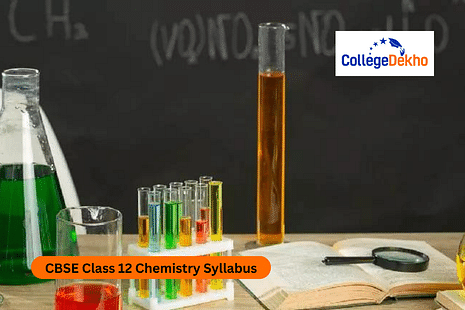

Never Miss an Exam Update
CBSE Class 12 Chemistry Syllabus 2026 is set by the CBSE board. The board has designed a syllabus that includes 10 units providing overall knowledge of the subject to students. These units consist of different important chapters. You can prepare the syllabus well for a theory exam of 70 marks and practical exam worth 30 marks. According to the syllabus, you can prepare a schedule and pay more attention to the topics with high marks. In addition, you can also check the CBSE Class 12 Chemistry exam pattern to get an idea about the types of questions in exams. Try to complete the syllabus in advance and solve the sample question papers and previous year question papers. For more details about the CBSE Class 12th Chemistry Syllabus 2026, continue reading the article.
Also Read - CBSE Class 12 Date Sheet 2026
CBSE Class 12 Chemistry Syllabus 2026: Chapter-Wise
The chapter-wise and topic-wise syllabus has been discussed below:
Unit II: Solutions [10 Periods]
Types of solutions, expression of concentration of solutions of solids in liquids, solubility of gases in liquids, solid solutions, Raoult's law, colligative properties - relative lowering of vapour pressure, elevation of boiling point, depression of freezing point, osmotic pressure, determination of molecular masses using colligative properties, abnormal molecular mass, Van't Hoff factor.
Unit III: Electrochemistry [12 Periods]
Redox reactions, EMF of a cell, standard electrode potential, Nernst equation and its application to chemical cells, Relation between Gibbs energy change and EMF of a cell, conductance in electrolytic solutions, specific and molar conductivity, variations of conductivity with concentration, Kohlrausch's Law, electrolysis and law of electrolysis (elementary idea), dry cell-electrolytic cells and Galvanic cells, lead accumulator, fuel cells, corrosion.
Unit IV: Chemical Kinetics [10 Periods]
Rate of a reaction (Average and instantaneous), factors affecting rate of reaction: concentration, temperature, catalyst; order and molecularity of a reaction, rate law and specific rate constant, integrated rate equations and half-life (only for zero and first order reactions), concept of collision theory (elementary idea, no mathematical treatment), activation energy, Arrhenius equation.
Unit VIII: d and f Block Elements [12 Periods]
General introduction, electronic configuration, occurrence and characteristics of transition metals, general trends in properties of the first-row transition metals – metallic character, ionization enthalpy, oxidation states, ionic radii, colour, catalytic property, magnetic properties, interstitial compounds, alloy formation, preparation and properties of K 2 Cr 2 O 7 and KMnO 4 .
- Lanthanoids: Electronic configuration, oxidation states, chemical reactivity and lanthanoid contraction and its consequences.
- Actinoids: Electronic configuration, oxidation states, and comparison with lanthanoids.
Unit IX: Coordination Compounds [12 Periods]
Coordination compounds: Introduction, ligands, coordination number, colour, magnetic properties and shapes, IUPAC nomenclature of mononuclear coordination compounds. Bonding, Werner's theory, VBT, and CFT; structure and stereoisomerism, importance of coordination compounds (in qualitative analysis, extraction of metals and biological system).
Unit X: Haloalkanes and Haloarenes [10 Periods]
- Haloalkanes: Nomenclature, nature of C–X bond, physical and chemical properties, optical rotation mechanism of substitution reactions.
- Haloarenes: Nature of C–X bond, substitution reactions (Directive influence of halogen in monosubstituted compounds only). Uses and environmental effects of - dichloromethane, trichloromethane, tetrachloromethane, iodoform, freons, DDT.
Unit XI: Alcohols, Phenols, and Ethers [10 Periods]
- Alcohols: Nomenclature, methods of preparation, physical and chemical properties (of primary alcohols only), identification of primary, secondary and tertiary alcohols, mechanism of dehydration, uses with special reference to methanol and ethanol.
- Phenols: Nomenclature, methods of preparation, physical and chemical properties, acidic nature of phenol, electrophilic substitution reactions, uses of phenols.
- Ethers: Nomenclature, methods of preparation, physical and chemical properties, uses.
Unit XII: Aldehydes, Ketones and Carboxylic Acids [10 Periods]
- Aldehydes and Ketones: Nomenclature, nature of carbonyl group, methods of preparation, physical and chemical properties, mechanism of nucleophilic addition, reactivity of alpha hydrogen in aldehydes, uses.
- Carboxylic Acids: Nomenclature, acidic nature, methods of preparation, physical and chemical properties; uses.
Unit XIII: Amines [10 Periods]
- Amines: Nomenclature, classification, structure, methods of preparation, physical and chemical properties, uses, and identification of primary, secondary and tertiary amines.
- Diazonium salts: Preparation, chemical reactions and importance in synthetic organic chemistry.
Unit XIV: Biomolecules [12 Periods]
- Carbohydrates: Classification (aldoses and ketoses), monosaccharides (glucose and fructose), D-L configuration oligosaccharides (sucrose, lactose, maltose), polysaccharides (starch, cellulose, glycogen); Importance of carbohydrates.
- Proteins: Elementary idea of - amino acids, peptide bonds, polypeptides, proteins, structure of proteins - primary, secondary, tertiary structure and quaternary structures (qualitative idea only), denaturation of proteins; enzymes. Hormones - Elementary idea excluding structure.
- Vitamins: Classification and functions.
- Nucleic Acids: DNA and RNA.
CBSE Class 12 Chemistry Theory Exam Marking Scheme
Check the details for the marking scheme for each chapter in the theory exam.
Title | Marks |
|---|---|
Solutions | 7 |
Electrochemistry | 9 |
Chemical Kinetics | 7 |
D an f clock elements | 7 |
Haloalkanes and Haloarenes | 6 |
Alcohols, Phenols and Ethers | 6 |
Aldehydes, Ketones and Carboxylic Acids | 8 |
Amines | 6 |
Biomolecules | 7 |
Total | 70 |
Also Read: CBSE Class 12 Chemistry Important Questions 2026
CBSE Class 12 Chemistry Syllabus 2026 For Practicals
Go through the topic-wise CBSE class 12 Chemistry syllabus 2026:
Surface Chemistry(a) Preparation of one lyophilic and one lyophobic sol
- Lyophilic sol-starch, egg albumin and gum
- Lyophobic sol - aluminium hydroxide, ferric hydroxide, arsenous sulphide.
(b) Dialysis of sol-prepared in (a) above.
(c) Study of the role of emulsifying agents in stabilizing the emulsion of different oils.
Chemical Kinetics(a) Effect of concentration and temperature on the rate of reaction between Sodium Thiosulphate and Hydrochloric acid.
(b) Study of reaction rates of any one of the following:
- Reaction of Iodide ion with Hydrogen Peroxide at room temperature using different concentrations of Iodide ions.
- Reaction between Potassium Iodate, (KIO 3 ) and Sodium Sulphite: (Na 2 SO 3 ) using starch solution as indicator (clock reaction).
Any one of the following experiments
- i) Enthalpy of dissolution of Copper Sulphate or Potassium Nitrate.
- ii) Enthalpy of neutralization of strong acid (HCl) and strong base (NaOH).
iii) Determination of enthalpy change during interaction (Hydrogen bond formation) between Acetone and Chloroform.
Electrochemistryi) Variation of cell potential in Zn/Zn 2+ || Cu 2+ /Cu with change in concentration of electrolytes (CuSO 4 or ZnSO 4 ) at room temperature.
Chromatography
i) Separation of pigments from extracts of leaves and flowers by paper chromatography and determination of Rf values.
ii) Separation of constituents present in an inorganic mixture containing two cations only (constituents having large differences in Rf values to be provided).
Preparation of Inorganic Compounds
i) Preparation of double salt of Ferrous Ammonium Sulphate or Potash Alum. Preparation of Potassium Ferric Oxalate.
Preparation of Organic Compounds
Preparation of any one of the following compounds
i) Acetanilideii) Di -benzalAcetone
iii) p-Nitroacetanilide
iv) Aniline yellow or 2 - Naphthol Aniline dye.
Tests for the functional groups present in organic compounds:
Unsaturation, alcoholic, phenolic, aldehydic, ketonic, carboxylic, and amino (Primary) groups.
Characteristic tests of carbohydrates, fats and proteins in pure samples and their detection in given foodstuffs.Determination of concentration/ molarity of KMnO4 solution by titrating it against a standard solution of:
i) Oxalic acid,
ii) Ferrous Ammonium Sulphate (Students will be required to prepare standard solutions by weighing themselves).
Qualitative analysis
Determination of one cation and one anion in a given salt. Cation : Pb 2+ , Cu 2+ As3 + , Aℓ 3+ , Fe 3+ , Mn 2+ , Zn 2+ , Cu 2+ , Ni 2+ , Ca 2+ , Sr 2+ , Ba 2 +, Mg 2+ , NH 4+ Anions: (CO 2 ) 2- , S 2- , (SO 3 ) 2- , (NO 2 ) - , (SO 4 ) 2- , Cℓ - , Br - , I - , PO 3- 4, (C 2 O 4 ) 2- , CH 3 COO - ,NO 3 -
(Note: Insoluble salts excluded)
Also Read -
CBSE Class 12 Chemistry Sample Paper
CBSE Class 12 Practical Exam Marking Scheme 2026
From the table below, check the marking scheme for the practical exam.
Evaluation Scheme for Examination | Marks |
|---|---|
Volumetric Analysis | 08 |
Salt Analysis | 08 |
Content Based Experiment | 06 |
Project Work | 04 |
Class record and viva | 04 |
Total | 30 |
CBSE Class 12th Chemistry Syllabus PDF 2026
Download the CBSE Class 12 Chemistry syllabus for 2026 in the PDF format from the table below.
| Particulars | Download PDF |
|---|---|
| CBSE 12th Chemistry Syllabus | Download Now |
CBSE Class 12 Chemistry Syllabus 2026 can be checked in detail here. You can keep visiting the page to ensure if there are any changes in the CBSE class 12th Chemistry syllabus.
Are you feeling lost and unsure about what career path to take after completing 12th standard?
Say goodbye to confusion and hello to a bright future!

FAQs
You can divide the CBSE Class 12 Chemistry syllabus 2025-26 into small parts and make a schedule. Ensure you complete the syllabus in advance that gives you time to revise the syllabus.
The CBSE class 12th Chemistry exam 2026 will be conducted for 100 marks, where 70 marks will be allotted for the theory portion, and the remaining 30 marks will be for the practical exams.
You can find the CBSE class 12 Chemistry Syllabus 2025-26 on the CBSE Board’s official website at cbseacademic.nic.in. You can also access the detailed syllabus from this page.
In the CBSE Class 12 Chemistry Syllabus 2026, the maximum weightage carrying chapter is Electrochemistry. This unit will be carrying a total of 09 marks.
The CBSE class 12 Chemistry theory exam paper 2026 is divided into two parts: Section A and Section B. Section A which will carry 20 marks will comprise 5 one-mark questions, whereas Section B which will carry 50 marks, will have 10 two-mark questions, 10 three-mark questions, and 5 five-mark questions.
Was this article helpful?




























